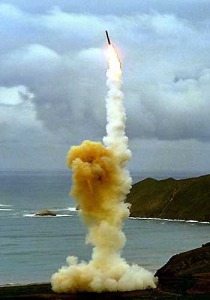 VANDENBERG AIR FORCE BASE, Calif. -- An LGM-30 Minuteman III missile soars in the air after a test launch. The Minuteman is a strategic weapon system using a ballistic missile of intercontinental range. (U.S. Air Force photo)
VANDENBERG AIR FORCE BASE, Calif. -- An LGM-30 Minuteman III missile soars in the air after a test launch. The Minuteman is a strategic weapon system using a ballistic missile of intercontinental range. (U.S. Air Force photo)
By Greg Thielmann
When traveling the interstate on a long car trip, it's usually better to get up to maximum safe speed rather than creeping along at the legal minimum.
Likewise, in order to achieve the full benefits of the New Strategic Arms Reduction Treaty (New START), it would be highly desirable to commit the United States to reaching the treaty's limits as soon as possible.
Those seeking additional contributions to national security from arms control negotiations have been focusing on "next steps" following the entry into force of New START. U.S. ratification of the Comprehensive Nuclear Test Ban Treaty (CTBT) -- one of the most important goals in President Barack Obama's Prague agenda -- was highlighted at the Arms Control Association's annual meeting this week and promoted by Undersecretary of State Ellen Tauscher and U.S. Senators Robert Casey (D-Pa.) and Jeanne Shaheen (D-N.H.). But with little Senate exposure to the many relevant developments since the CTBT was last debated and with a new crop of senators in the 112th Congress, much educational effort will be needed before the treaty can again be brought to a vote.
As for achieving a follow-on treaty to New START, the challenges are numerous and daunting. Much preparatory work and tough negotiating will be required.
It is fitting, therefore, to embrace an opportunity to accelerate strategic nuclear arms reductions in a way that would immediately advance nonproliferation goals and facilitate deficit reduction efforts while requiring minimal expenditure of political capital. President Obama need only announce that the United States will meet the New START limits by 2015 instead of 2018 and order the military to make it happen.
New START's numerical limits (700 deployed strategic ballistic missiles and heavy bombers, 800 deployed and non-deployed strategic ballistic missile launchers and heavy bombers, and 1,550 strategic ballistic missile and heavy bomber warheads) can be achieved much earlier than the seven-years allowed under the treaty. In ratifying New START, the Russian and U.S. governments – including their legislative branches and their militaries -- have attested to the acceptability of these lower limits. In fact, as is evident from the data released this week in the Kristensen-Norris "Nuclear Notebook," the Russians are already below the 700/800 delivery vehicle limits and only 110 above the 1,550 warhead limit. With so many of their warheads currently deployed on older, heavily MIRVed SS-18 and SS-19 ICBMs, which are bumping up against retirement schedules in the next few years, Russia is likely to fall below the 1,550 limit well before the United States does.
The United States is planning to reach the new limits by converting some bombers to conventional-only missions, retiring some Minuteman III ICBMs and de-MIRVing some others, and "eliminating" four launch tubes on each of its strategic ballistic missile submarines. Accomplishing these tasks in the next three years will not strain budgets or stress operational forces; it will reduce the expense of maintaining strategic deterrent forces in the out years.
The realities of the numerical trends have led to calls from U.S. and Russian experts and former officials to speed up reductions. Former Secretary of State Madeleine Albright and former Russian Foreign Minister Igor Ivanov argued in The New York Times April 6 that both sides could reach the limits by 2014 or 2015. In her remarks at the ACA annual meeting, Senator Shaheen explicitly endorsed the concept. A Ploughshares Fund/PIR Center study by a group of senior U.S. and Russian security experts recently made a similar recommendation: "The U.S. and Russia could accelerate the reductions mandated by New START ahead of the 2018 implementation deadline, so that they are implemented by 2014 (prior to the next NPT Review Conference)."
There is a powerful precedent for such a move. The 2002 Strategic Offensive Reductions Treaty negotiated by the George W. Bush administration required the two sides to reduce operationally deployed strategic warheads to 2,200 by the end of 2012. However, the United States fell below warhead limits more than three years ahead of the deadline, even while Russian forces were still several hundred warheads higher than the United States' and before New START had created an obligation for further U.S. and Russian reductions.
Accelerating reductions would free up resources for other critical Defense Department needs and help reduce the deficit. It would further enhance U.S. credibility in pursuing nuclear nonproliferation, increasing leverage for dissuading other countries from pursuing nuclear weapons. It would also lower the incentives for Russia to develop and deploy new, heavy ICBMs and would foster opportunities for other unilateral initiatives aimed at reducing the role of nuclear weapons.
There are ample reasons to pick up the pace. Step on it!
